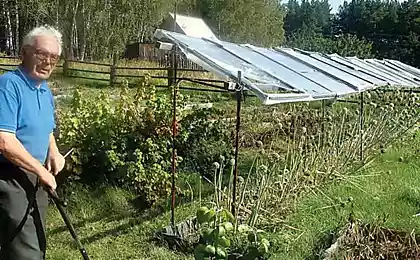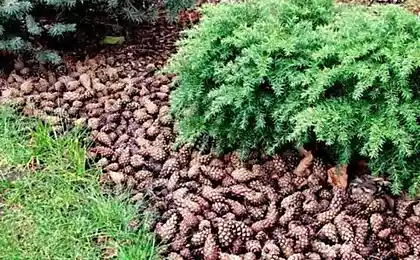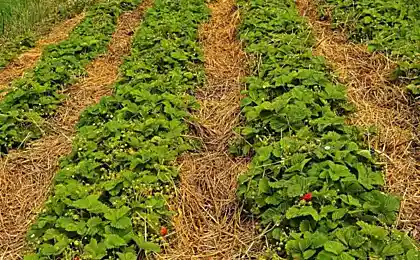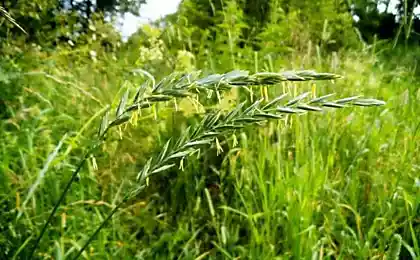571
High-yielding beds in the Kurdyumov: a minimum of labor and a maximum of natural forces
We natural and organic gardeners, we use a different approach: the minimum work-maximum of natural forces — optimum and healthy crop. Our tool — permanent beds, often raised, and sometimes, on the contrary, in-depth. they allow you to replace a bad job at reasonable. The result is more stable yields in any year.
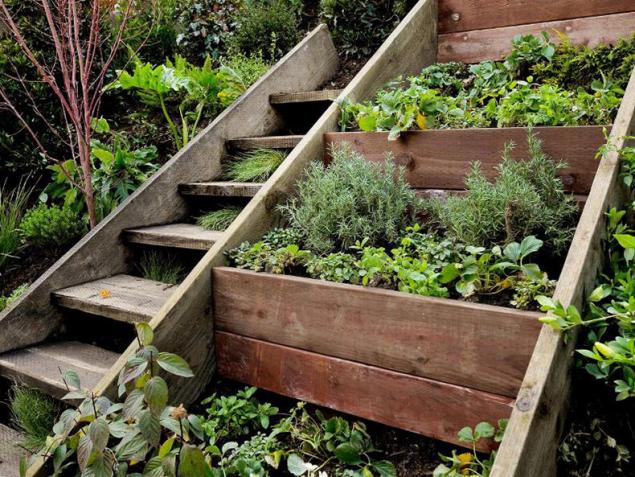
The beds at the Kurdyumov: the first Way
If the soil in your garden is easy enough, you can just plan ridge, slightly raising them. The main thing after that — not to destroy living structure of the soil with a shovel. Instead, improve fertility every year, adding on top of the ridge organics and sowing "green manure" — cover crops.
The beds at the Kurdyumov: Method two
Another option is to create a garden bed in layers. Thus you'll accelerate the decay of organic matter. In this case, you will not need any forks or even the plane. The layer of plant residues in autumn lightly sprinkle garden soil. It's almost winter, under this "blanket" will continue to work with microbes and mushrooms, much longer in such working conditions and worms. Spring is at your disposal soiled bed, ready for sowing or planting. And so every year.
The beds at the Kurdyumov: the third Way
Many growers successfully use a bed of Mittlaider – narrow with wide aisles. But if you have a little land, wide aisles — is a luxury, their rational to replace narrow. Have a narrow passage and its undeniable advantages: they emit less than half moisture, half easier to cover a thick layer of plant residues.
And not necessarily pour back the kilograms of fertilizer and pour tons of water, poisoning the nearby decks. A bed you can fill with all the same organic matter in combination with various EM-infusions. And in aisles not grow weeds, their annual covered with layer of mulch. After all, as you probably already know, one of the main principles of the natural garden — try to make sure to never have bare soil.
Narrow beds can be very simply and quickly "build" by making high. Bulk out the beds of the crests. In cold climates they are optimal: in the spring before thaw and warm in summer entirely covered by plants, and in autumn less than get wet from the rain.
Very well on some of the ridges you feel the roots. Especially onions. As you know, it is much better than pouring the onion, if it's all warm from the sun.
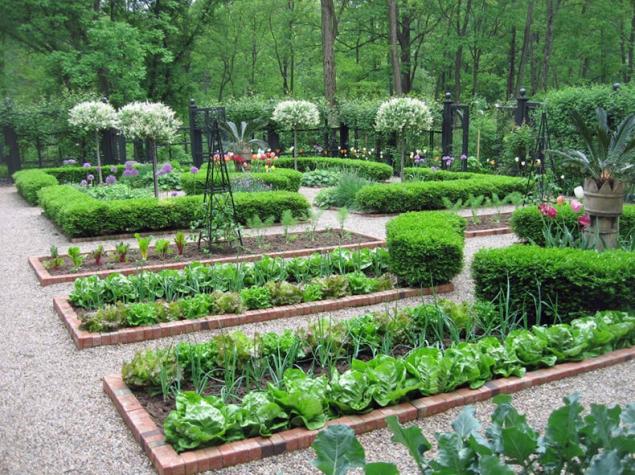
The beds at the Kurdyumov: the fourth Way
And yet I prefer beds with borders. Maybe because I live in the South and in my area loamy soil. Because of this, we work very hard with the ground. Only limited space is radically improved with sand and organic matter, it somehow lends itself to the plane! Therefore, staying in the Kuban, I built boxes.
Just life has forced. For the beginning made them from what was: of the slab and old boards. And these boards are rot for ten years, allowing you to create the beds are quite good soil. And when they began to go into a state of the compost, I don't regret the money and ordered a local Forester neat oak trunks.
They my patch about live another fifteen years. In addition, a convenient log to sit down. They are a little stronger. And harder into the soil quickly dented. Yes, and look much better boards. And store more heat, warming. In General, continuous pleasure! In those regions where the boards are not the deficit, gardeners build boxes from the major boards. They serve at least 15 years. This fertile material.
Paint over a couple of times impregnation and the box will last much longer. And spending a little money and time can be of the same boards to collect neat hotbed.
Lots of available slate. The main advantage of this material does not rot. Especially convenient when constructing beds wavy slate. Dug into the ground, it will be very stable through bends. By the way, slate is also convenient to make boxes in greenhouses. Easy to work with: with a little effort, slide the cutter across the surface and break at the resulting line.
If possible, you can use concrete curbs, and paving slabs. This garden has for decades. And most importantly, the box will fit into the overall garden design. On such tracks it's nice to walk in Slippers, but it is particularly convenient to haul garden cart. Agree, work so much nicer.
The real delights of garden architecture and vegetable containers. Their filling is similar to a compost trenches and beds Holzer: on the bottom place dry twigs, then a layer of fertile soil mixed with organic matter.
Brick containers under the canopy is a classic of the genre. The roof does not give the morning dew to get to the plants, as a result, they suffer much less from disease. At the same time, the canopy reduces radiation frost, and cold air is spread mainly but the soil flowing around the brick side of the ridges. Early spring in a container you can bury a bit of manure to heat the soil. And in the summer the roof will reduce excess sunlight. Well, as comfortable to work without bending, to say not even have. Watering needed very rarely. One major drawback: it is necessary to build! But it at desire can be overcome.
In the garden are often necessary tapestries.
I, for example, simply welded over the garden solid rigid construction: above each bed two longitudinal rods for garters. Now no problem, we tied even peppers.

Saving mulch
One of the gardening techniques, completely eliminates the need for hoeing, weeding and frequent watering, leak-mulch and black film. Under it great potatoes grow, feel good all cucurbits, particularly melons and watermelons. Because the black material is a great heat generator in the spring. But most often this kind of mulch do for strawberries. Under the film making compost, humus, and between them and the sawdust. Cover the patch with tape, put the Board — from the wind to also be able to walk. The edges of the film must tightly was added dropwise.
Comparison of heat loss of houses from different materials
How to create a cucumber
Drastic measures
If your garden is too poor or too heavy soil, do not despair. All fixable! But will have to resort to drastic transformations.
On the site of the future garden beds fully remove the soil. At the bottom of the resulting trenches, lay the dry weeds, branches and trunks. Then fill them with a mixture of compost-humus, sand or rotting sawdust mixed with top soil. Aisle don't forget to cover black polypropylene geotextile. The final touch: the beds turn-over boards. Now, in the trenches it's easy to add organics, and the plane will not tear the material.
Black geotextile between the rows — three in one: moisture and a and weed no problems and plus heat in the soil.published
© Nikolay Kurdyumov
Source: vsaduidoma.com/2015/10/17/gryadki-po-kurdyumovu/

The beds at the Kurdyumov: the first Way
If the soil in your garden is easy enough, you can just plan ridge, slightly raising them. The main thing after that — not to destroy living structure of the soil with a shovel. Instead, improve fertility every year, adding on top of the ridge organics and sowing "green manure" — cover crops.
The beds at the Kurdyumov: Method two
Another option is to create a garden bed in layers. Thus you'll accelerate the decay of organic matter. In this case, you will not need any forks or even the plane. The layer of plant residues in autumn lightly sprinkle garden soil. It's almost winter, under this "blanket" will continue to work with microbes and mushrooms, much longer in such working conditions and worms. Spring is at your disposal soiled bed, ready for sowing or planting. And so every year.
The beds at the Kurdyumov: the third Way
Many growers successfully use a bed of Mittlaider – narrow with wide aisles. But if you have a little land, wide aisles — is a luxury, their rational to replace narrow. Have a narrow passage and its undeniable advantages: they emit less than half moisture, half easier to cover a thick layer of plant residues.
And not necessarily pour back the kilograms of fertilizer and pour tons of water, poisoning the nearby decks. A bed you can fill with all the same organic matter in combination with various EM-infusions. And in aisles not grow weeds, their annual covered with layer of mulch. After all, as you probably already know, one of the main principles of the natural garden — try to make sure to never have bare soil.
Narrow beds can be very simply and quickly "build" by making high. Bulk out the beds of the crests. In cold climates they are optimal: in the spring before thaw and warm in summer entirely covered by plants, and in autumn less than get wet from the rain.
Very well on some of the ridges you feel the roots. Especially onions. As you know, it is much better than pouring the onion, if it's all warm from the sun.

The beds at the Kurdyumov: the fourth Way
And yet I prefer beds with borders. Maybe because I live in the South and in my area loamy soil. Because of this, we work very hard with the ground. Only limited space is radically improved with sand and organic matter, it somehow lends itself to the plane! Therefore, staying in the Kuban, I built boxes.
Just life has forced. For the beginning made them from what was: of the slab and old boards. And these boards are rot for ten years, allowing you to create the beds are quite good soil. And when they began to go into a state of the compost, I don't regret the money and ordered a local Forester neat oak trunks.
They my patch about live another fifteen years. In addition, a convenient log to sit down. They are a little stronger. And harder into the soil quickly dented. Yes, and look much better boards. And store more heat, warming. In General, continuous pleasure! In those regions where the boards are not the deficit, gardeners build boxes from the major boards. They serve at least 15 years. This fertile material.
Paint over a couple of times impregnation and the box will last much longer. And spending a little money and time can be of the same boards to collect neat hotbed.
Lots of available slate. The main advantage of this material does not rot. Especially convenient when constructing beds wavy slate. Dug into the ground, it will be very stable through bends. By the way, slate is also convenient to make boxes in greenhouses. Easy to work with: with a little effort, slide the cutter across the surface and break at the resulting line.
If possible, you can use concrete curbs, and paving slabs. This garden has for decades. And most importantly, the box will fit into the overall garden design. On such tracks it's nice to walk in Slippers, but it is particularly convenient to haul garden cart. Agree, work so much nicer.
The real delights of garden architecture and vegetable containers. Their filling is similar to a compost trenches and beds Holzer: on the bottom place dry twigs, then a layer of fertile soil mixed with organic matter.
Brick containers under the canopy is a classic of the genre. The roof does not give the morning dew to get to the plants, as a result, they suffer much less from disease. At the same time, the canopy reduces radiation frost, and cold air is spread mainly but the soil flowing around the brick side of the ridges. Early spring in a container you can bury a bit of manure to heat the soil. And in the summer the roof will reduce excess sunlight. Well, as comfortable to work without bending, to say not even have. Watering needed very rarely. One major drawback: it is necessary to build! But it at desire can be overcome.
In the garden are often necessary tapestries.
I, for example, simply welded over the garden solid rigid construction: above each bed two longitudinal rods for garters. Now no problem, we tied even peppers.

Saving mulch
One of the gardening techniques, completely eliminates the need for hoeing, weeding and frequent watering, leak-mulch and black film. Under it great potatoes grow, feel good all cucurbits, particularly melons and watermelons. Because the black material is a great heat generator in the spring. But most often this kind of mulch do for strawberries. Under the film making compost, humus, and between them and the sawdust. Cover the patch with tape, put the Board — from the wind to also be able to walk. The edges of the film must tightly was added dropwise.
Comparison of heat loss of houses from different materials
How to create a cucumber
Drastic measures
If your garden is too poor or too heavy soil, do not despair. All fixable! But will have to resort to drastic transformations.
On the site of the future garden beds fully remove the soil. At the bottom of the resulting trenches, lay the dry weeds, branches and trunks. Then fill them with a mixture of compost-humus, sand or rotting sawdust mixed with top soil. Aisle don't forget to cover black polypropylene geotextile. The final touch: the beds turn-over boards. Now, in the trenches it's easy to add organics, and the plane will not tear the material.
Black geotextile between the rows — three in one: moisture and a and weed no problems and plus heat in the soil.published
© Nikolay Kurdyumov
Source: vsaduidoma.com/2015/10/17/gryadki-po-kurdyumovu/
